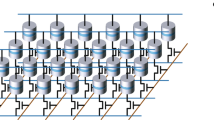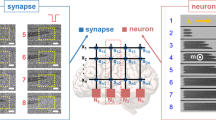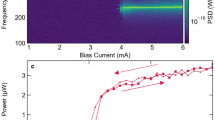Abstract
Spintronic nano-synapses and nano-neurons perform neural network operations with high accuracy thanks to their rich, reproducible and controllable magnetization dynamics. These dynamical nanodevices could transform artificial intelligence hardware, provided they implement state-of-the-art deep neural networks. However, there is today no scalable way to connect them in multilayers. Here we show that the flagship nano-components of spintronics, magnetic tunnel junctions, can be connected into multilayer neural networks where they implement both synapses and neurons thanks to their magnetization dynamics, and communicate by processing, transmitting and receiving radiofrequency signals. We build a hardware spintronic neural network composed of nine magnetic tunnel junctions connected in two layers, and show that it natively classifies nonlinearly separable radiofrequency inputs with an accuracy of 97.7%. Using physical simulations, we demonstrate that a large network of nanoscale junctions can achieve state-of-the-art identification of drones from their radiofrequency transmissions, without digitization and consuming only a few milliwatts, which constitutes a gain of several orders of magnitude in power consumption compared to currently used techniques. This study lays the foundation for deep, dynamical, spintronic neural networks.
This is a preview of subscription content, access via your institution
Access options
Access Nature and 54 other Nature Portfolio journals
Get Nature+, our best-value online-access subscription
$29.99 / 30 days
cancel any time
Subscribe to this journal
Receive 12 print issues and online access
$259.00 per year
only $21.58 per issue
Buy this article
- Purchase on Springer Link
- Instant access to full article PDF
Prices may be subject to local taxes which are calculated during checkout




Similar content being viewed by others
Data availability
The data supporting the figures of this study are publicly available in the Zenodo repository: https://doi.org/10.5281/zenodo.7956045.
Code availability
The source codes used in this study, in particular to generate the data of Fig. 4, are publicly available in the Github repository: https://github.com/neurophysics-cnrsthales/rf_spintronic_nn.
References
LeCun, Y., Bengio, Y. & Hinton, G. Deep learning. Nature 521, 436–444 (2015).
Christensen, D. V. et al. 2022 roadmap on neuromorphic computing and engineering. Neuromorphic Comput. Eng. 2, 022501 (2022).
Grollier, J. et al. Neuromorphic spintronics. Nat. Electron. 3, 360–370 (2020).
Worledge, D. C. Spin-Transfer-Torque MRAM: the next revolution in memory. In 2022 IEEE International Memory Workshop (IMW) 1–4 (IEEE, 2022).
Safranski, C., Sun, J. Z. & Kent, A. D. A perspective on electrical generation of spin current for magnetic random access memories. Appl. Phys. Lett. 120, 160502 (2022).
Lequeux, S. et al. A magnetic synapse: multilevel spin-torque memristor with perpendicular anisotropy. Sci. Rep. 6, 31510 (2016).
Kurenkov, A. et al. Artificial neuron and synapse realized in an antiferromagnet/ferromagnet heterostructure using dynamics of spin–orbit torque switching. Adv. Mater. 31, 1900636 (2019).
Chen, R. et al. Nanoscale room-temperature multilayer skyrmionic synapse for deep spiking neural networks. Phys. Rev. Appl. 14, 014096 (2020).
Song, K. M. et al. Skyrmion-based artificial synapses for neuromorphic computing. Nat. Electron. 3, 148–155 (2020).
Mansueto, M. et al. Spintronic memristors for neuromorphic circuits based on the angular variation of tunnel magnetoresistance. Nanoscale 13, 11488–11496 (2021).
Zhang, X. et al. Spin-torque memristors based on perpendicular magnetic tunnel junctions for neuromorphic computing. Adv. Sci. 8, 2004645 (2021).
Xu, J.-W. et al. A quantum material spintronic resonator. Sci. Rep. 11, 15082 (2021).
Kiraly, B., Knol, E. J., van Weerdenburg, W. M. J., Kappen, H. J. & Khajetoorians, A. A. An atomic Boltzmann machine capable of self-adaption. Nat. Nanotechnol. 16, 414–420 (2021).
Leroux, N. et al. Hardware realization of the multiply and accumulate operation on radio-frequency signals with magnetic tunnel junctions. Neuromorphic Comput. Eng. https://doi.org/10.1088/2634-4386/abfca6 (2021).
Monalisha, P., Kumar, A. P. S., Wang, X. R. & Piramanayagam, S. N. Emulation of synaptic plasticity on a cobalt-based synaptic transistor for neuromorphic computing. ACS Appl. Mater. Interfaces 14, 11864–11872 (2022).
Torrejon, J. et al. Neuromorphic computing with nanoscale spintronic oscillators. Nature 547, 428–431 (2017).
Prychynenko, D. et al. Magnetic skyrmion as a nonlinear resistive element: a potential building block for reservoir computing. Phys. Rev. Appl. 9, 014034 (2018).
Borders, W. A. et al. Integer factorization using stochastic magnetic tunnel junctions. Nature 573, 390–393 (2019).
Tsunegi, S. et al. Physical reservoir computing based on spin torque oscillator with forced synchronization. Appl. Phys. Lett. 114, 164101 (2019).
Koo, M. et al. Distance computation based on coupled spin-torque oscillators: application to image processing. Phys. Rev. Appl. 14, 034001 (2020).
Zahedinejad, M. et al. Two-dimensional mutually synchronized spin Hall nano-oscillator arrays for neuromorphic computing. Nat. Nanotechnol. 15, 47–52 (2020).
Ababei, R. V. et al. Neuromorphic computation with a single magnetic domain wall. Sci. Rep. 11, 15587 (2021).
Watt, S., Kostylev, M., Ustinov, A. B. & Kalinikos, B. A. Implementing a magnonic reservoir computer model based on time-delay multiplexing. Phys. Rev. Appl. 15, 064060 (2021).
Mazza, L. et al. Computing with injection-locked spintronic diodes. Phys. Rev. Appl. 17, 014045 (2022).
Zahedinejad, M. et al. Memristive control of mutual spin Hall nano-oscillator synchronization for neuromorphic computing. Nat. Mater. 21, 81–87 (2022).
Romera, M. et al. Vowel recognition with four coupled spin-torque nano-oscillators. Nature 563, 230–234 (2018).
Romera, M. et al. Binding events through the mutual synchronization of spintronic nano-neurons. Nat. Commun. 13, 883 (2022).
Finocchio, G. et al. Perspectives on spintronic diodes. Appl. Phys. Lett. 118, 160502 (2021).
Siafarikas, D. & Volakis, J. L. Toward direct RF sampling: implications for digital communications. IEEE Microw. Mag. 21, 43–52 (2020).
Farley, B., McGrath, J. & Erdmann, C. An all-programmable 16-nm RFSoC for digital-RF communications. IEEE Micro 38, 61–71 (2018).
Leroux, N. et al. Radio-frequency multiply-and-accumulate operations with spintronic synapses. Phys. Rev. Appl. 15, 034067 (2021).
Tulapurkar, A. A. et al. Spin-torque diode effect in magnetic tunnel junctions. Nature 438, 339–342 (2005).
Slavin, A. & Tiberkevich, V. Nonlinear auto-oscillator theory of microwave generation by spin-polarized current. IEEE Trans. Magn. 45, 1875–1918 (2009).
Wright, L. G. et al. Deep physical neural networks trained with backpropagation. Nature 601, 549–555 (2022).
Yoon, Y. H., Khan, S., Huh, J. & Ye, J. C. Efficient B-mode ultrasound image reconstruction from sub-sampled RF data using deep learning. IEEE Trans. Med. Imaging 38, 325–336 (2019).
Dai, M., Li, S., Wang, Y., Zhang, Q. & Yu, J. Post-processing radio-frequency signal based on deep learning method for ultrasonic microbubble imaging. Biomed. Eng. Online 18, 95 (2019).
Besler, E., Wang, Y. C. & Sahakian, A. V. Real-time radiofrequency ablation lesion depth estimation using multi-frequency impedance with a deep neural network and tree-based ensembles. IEEE Trans. Biomed. Eng. 67, 1890–1899 (2020).
Merchant, K., Revay, S., Stantchev, G. & Nousain, B. Deep learning for RF device fingerprinting in cognitive communication networks. IEEE J. Sel. Top. Signal Process. 12, 160–167 (2018).
Lien, J. et al. Soli: ubiquitous gesture sensing with millimeter wave radar. ACM Trans. Graph. 35, 142 (2016).
Basak, S., Rajendran, S., Pollin, S. & Scheers, B. Drone classification from RF fingerprints using deep residual nets. In 2021 International Conference on COMmunication Systems & NETworkS (COMSNETS) 548–555 (IEEE, 2021).
USRP X310 High-Performance Software Defined Radio https://www.ettus.com/all-products/x310-kit/ (Ettus Research).
Compare 10 Series Graphics Cards, GeForce https://www.nvidia.com/en-in/geforce/products/10series/compare/ (NVIDIA).
Chao, X., Jamali, M. & Wang, J.-P. Scaling effect of spin-torque nano-oscillators. AIP Adv. 7, 056624 (2017).
Marković, D., Mizrahi, A., Querlioz, D. & Grollier, J. Physics for neuromorphic computing. Nat. Rev. Phys. 2, 499–510 (2020).
Dussaux, A. et al. Large amplitude spin torque vortex oscillations at zero external field using a perpendicular spin polarizer. Appl. Phys. Lett. 105, 022404 (2014).
Tsunegi, S. et al. High emission power and Q factor in spin torque vortex oscillator consisting of FeB free layer. Appl. Phys. Express 7, 063009 (2014).
Choi, J.-G. et al. Voltage-driven gigahertz frequency tuning of spin Hall nano-oscillators. Nat. Commun. 13, 3783 (2022).
Martins, L. et al. Non-volatile artificial synapse based on a vortex nano-oscillator. Sci. Rep. 11, 16094 (2021).
Jiang, S. et al. Reduced spin torque nano-oscillator linewidth using He+ irradiation. Appl. Phys. Lett. 116, 072403 (2020).
Divinskiy, B., Urazhdin, S., Demokritov, S. O. & Demidov, V. E. Controlled nonlinear magnetic damping in spin-Hall nano-devices. Nat. Commun. 10, 5211 (2019).
Sethi, P. et al. Compensation of anisotropy in spin-Hall devices for neuromorphic applications. Phys. Rev. Appl. 19.6, 064018 (2023).
Jenkins, A. S., Alvarez, L. S. E., Freitas, P. P. & Ferreira, R. Digital and analogue modulation and demodulation scheme using vortex-based spin torque nano-oscillators. Sci. Rep. 10, 11181 (2020).
Jung, S. et al. A crossbar array of magnetoresistive memory devices for in-memory computing. Nature 601, 211–216 (2022).
Craven, M. P., Curtis, K. M. & Hayes-Gill, B. R. Frequency division multiplexing in analogue neural network. Electron. Lett. 27, 918–920 (1991).
Leroux, N. et al. Convolutional neural networks with radio-frequency spintronic nano-devices. Neuromorphic Comput. Eng. 2, 034002 (2022).
Noh, S. et al. Spin dynamics in ferromagnetic resonance for nano-sized magnetic dot arrays: metrology and insight into magnetization dynamics. IEEE Trans. Magn. 47, 2387–2390 (2011).
Litvinenko, A. et al. Ultrafast GHz-range swept-tuned spectrum analyzer with 20 ns temporal resolution based on a spin-torque nano-oscillator with a uniformly magnetized ‘free’ layer. Nano Lett. 22, 1874–1879 (2022).
Kurokawa, Y. et al. Ultra-wide-band millimeter-wave generator using spin torque oscillator with strong interlayer exchange couplings. Sci. Rep. 12, 10849 (2022).
Bonetti, S., Muduli, P., Mancoff, F. & Åkerman, J. Spin torque oscillator frequency versus magnetic field angle: the prospect of operation beyond 65 GHz. Appl. Phys. Lett. 94, 102507 (2009).
Khymyn, R. et al. Ultra-fast artificial neuron: generation of picosecond-duration spikes in a current-driven antiferromagnetic auto-oscillator. Sci. Rep. 8, 15727 (2018).
Chakravarty, A. et al. Supervised learning of an opto-magnetic neural network with ultrashort laser pulses. Appl. Phys. Lett. 114, 192407 (2019).
Scellier, B. & Bengio, Y. Equilibrium propagation: bridging the gap between energy-based models and backpropagation. Front. Comput. Neurosci. 11, 24 (2017).
Akiba, T., Sano, S., Yanase, T., Ohta, T. & Koyama, M. Optuna: a next-generation hyperparameter optimization framework. In Proceedings of the 25th ACM SIGKDD International Conference on Knowledge Discovery & Data Mining 2623–2631 (Association for Computing Machinery, 2019).
Acknowledgements
This work was supported by the European Union’s Horizon 2020 research and innovation programme under grant RadioSpin no. 101017098. The text of the article was partially edited by a large language model (OpenAI ChatGPT).
Author information
Authors and Affiliations
Contributions
The study was designed and supervised by J.G. and F.A.M.; samples were optimized and fabricated by R.F., A.S.J., L.M., L.B., M.S.C., P.A., A.S. and A.S.J.; experiments and training of the hardware neural network were performed by F.A.M., A.R., N.L., D.M., J.T. and D.S.-H.; simulations of neural networks and drone classification were performed by F.A.M., A.d.R. and N.L.; the estimation of scaled network performances was performed by F.A.M., N.L. and A.F.V.; and F.A.M., P.B., D.Q., T.T., J.-B.B. and S.S. provided insights on applications and circuit design. All authors contributed to the analysis of the results and writing of the paper.
Corresponding authors
Ethics declarations
Competing interests
The authors declare the following competing interests: patents FR 1800805, 1800806 and 1800807 are held by CNRS and Thales, and J.G. is the inventor. They cover the neural network architecture proposed in this work. The remaining authors declare no competing interests.
Peer review
Peer review information
Nature Nanotechnology thanks Jianhua Yang, Thomas Hayward and the other, anonymous, reviewer(s) for their contribution to the peer review of this work.
Additional information
Publisher’s note Springer Nature remains neutral with regard to jurisdictional claims in published maps and institutional affiliations.
Supplementary information
Supplementary Information
Supplementary Figs. 1–10 and Discussion.
Rights and permissions
Springer Nature or its licensor (e.g. a society or other partner) holds exclusive rights to this article under a publishing agreement with the author(s) or other rightsholder(s); author self-archiving of the accepted manuscript version of this article is solely governed by the terms of such publishing agreement and applicable law.
About this article
Cite this article
Ross, A., Leroux, N., De Riz, A. et al. Multilayer spintronic neural networks with radiofrequency connections. Nat. Nanotechnol. 18, 1273–1280 (2023). https://doi.org/10.1038/s41565-023-01452-w
Received:
Accepted:
Published:
Issue Date:
DOI: https://doi.org/10.1038/s41565-023-01452-w
This article is cited by
-
Non-hermiticity in spintronics: oscillation death in coupled spintronic nano-oscillators through emerging exceptional points
Nature Communications (2024)
-
Editors’ Choice 2023
Communications Engineering (2023)
-
Reconfigurable reservoir computing in a magnetic metamaterial
Communications Physics (2023)



